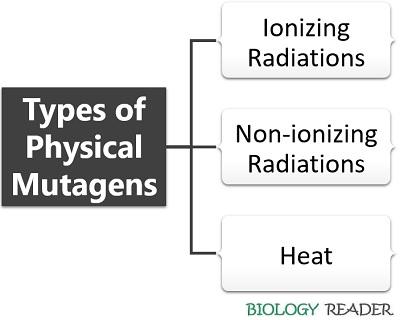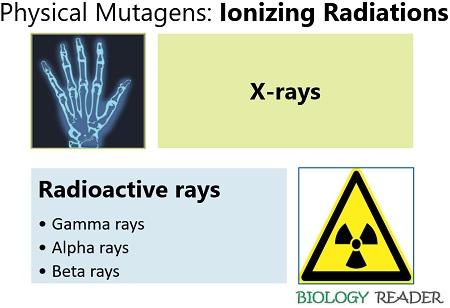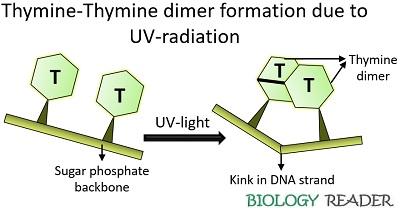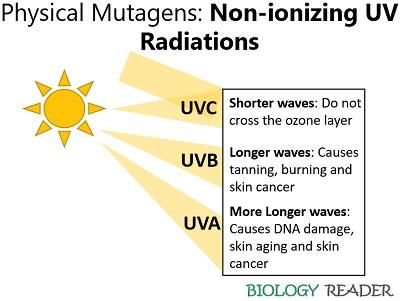Physical mutagenesis is a mutation in the cells, tissues and DNA of the organisms induced by physical mutagenic agents like radiation and heat. Thus, mutagenesis (muta: means changes and genesis: means origin or outset) is a phenomenon defined as the origination of any changes that can alter the gene sequence and structure, thereby causing mutation.
Physical mutagens mainly include sources of electromagnetic radiations like X-rays, α-rays, β-rays, UV-rays etc. and thermal heat, which can cause either direct DNA-damage or indirect DNA damage via highly reactive free radicals.
DNA is a heritable material, which replicates and passes down to the daughter cells. DNA replication accuracy is high, but some consequences may occur that can cause replication errors like mismatch base pairing, crosslinking, dimerization etc.
The mutation is primarily seen during DNA replication and translation due to the incorporation of some physical, chemical and biological mutagenic agents. In this context, we will focus only on the different types of physical mutagens, along with the definition of physical mutagenesis.
Content: Physical Mutagenesis
Definition of Physical Mutagenesis
It refers to the phenomena that cause mutation in the DNA structure through physical energy sources like ionizing radiations, non-ionizing radiations and heat. Ionizing radiations (like X-rays) primarily cause chain breaks in DNA. Oppositely, non-ionizing radiation (like UV-rays) causes covalent linkage between the adjacent bases. Heat is also a factor causing DNA denaturation under high heat.
Therefore, the sources responsible for the occurrence of physical mutagenesis are termed physical mutagens. Cells use different DNA-repair mechanisms to undo the changes that occurred in the DNA strand like excision repair, photoreactivation repair, mismatch repair and many more. But, the accumulation of mutation can cause cancer.
Causes of Physical Mutagenesis
Physical agents like radiations of the electromagnetic spectrum and heat induce physical mutagenesis, which is characterized by the following changes in the DNA:

- Single stranded breakage in DNA: It results due to the mismatched 5′ and/or 3′ termini of DNA. Double-stranded breakage becomes lethal and results in the case of two single-strand breaks in the opposite DNA strands. The DNA breakage is caused due to ionizing radiations.
- Base damage: It is the indirect DNA damage induced by the ionizing radiations through the formation of reactive free radicals. It involves mismatched base pairing due to addition, deletion and incorporation of the nitrogenous bases.
- Dimerization of bases: Pyrimidine dimers commonly form under exposure to UV-light. Thymine-thymine dimer is the most evident pyrimidine dimer among the thymine-cytosine, cytosine-cytosine, thymine-uracil and uracil-uracil.
- Crosslinking: Ionizing radiations cause interstrand crosslinking in the non-hybridized sequence of DNA.
Physical Mutagens
Some ionizing radiations (X-rays, α-rays, β-rays and γ-rays), non-ionizing radiation (UV-rays) and heat are the factors included in the group of physical mutagens. Let us discuss each of the factors responsible for physical mutagenesis in detail. Ionizing and non-ionizing radiations are part of electromagnetic radiations.

Radiations originate in the form of electromagnetic waves, which travel at the speed of light. The wavelength and energy of each electromagnetic radiation differ. Radiations below the wavelength of 340 nm are lethal for the DNA-molecules.
Therefore, we can say that the radiations cause damage at a molecular level, as they affect the DNA biomolecule directly (ionization or excitation) or indirectly through the formation of highly reactive free radicals.
Ionizing Radiations
X-rays, α-rays, β-rays and γ-rays are examples of ionizing radiations, which can induce DNA damage due to their high ionizing property. Ionizing radiations have a low wavelength and high energy or frequency.

X-rays originate through the source of accelerating electrons, while α-rays, β-rays and γ-rays originate through atomic nuclei. They produce reactive ions, atoms or molecules on ionization, damaging the sugar-phosphate backbone or the phosphate ester linkages.
Ionizing radiations mainly affect the rapidly dividing cells (like blood cells in the bone marrow and gastrointestinal tract). High-energy radiations can directly damage the DNA by causing chromosomal breakage (either one or both the strands), chromosomal rearrangement and DNA crosslinking.
However, ionizing radiations indirectly damage the DNA through the free radical effects by following the mechanism given below:

- High energy radiation penetrates the cells and tissues.
- Ionizes reactive ions (atoms or molecules).
- The free radicals or reactive species cut up the DNA strands in its path and rearrange the DNA fragments by altering the long stretches of DNA.
Reactive oxygen species may directly or indirectly affect the nuclear DNA by modifying bases incorporated within the DNA or deactivate the DNA-repair enzymes.
Non-ionizing Radiation
UV-radiation is a common example of non-ionizing radiation, which can induce DNA damage because of the skin cells’ high absorption capacity. Nucleic acid (DNA) readily absorbs UV-light of wavelength 280 nm. Thus, DNA acts as a target molecule of the UV-rays.
UV-radiation naturally originates from the sunlight and artificially through tanning beds. It has a high wavelength and low energy or penetration. Non-ionizing radiations result in DNA excitation due to photon (UVA and UVB) absorption by the cells.
As a result, crosslinking, base damage, dimer formation etc. may consequence. Dimerization in the pyrimidine bases is most evident than the purine bases. The steps involved in the dimerization of bases are as follows:

- Hydration of 4:5 bonds.
- Thymines are pulled towards one another.
- Distortion of DNA-helix.
- The weakening of the H-bond to the adjacent base adenine.
- Inhibits advancement of the replication fork.
UVA, UVB and UVC are the ultraviolet rays coming out of the sun. The earth’s ozone layer mostly absorbs UVC-rays. Only UVA and UVB rays reach the earth’s troposphere and cause diversified effects.
In concern to mutation, UVA-rays result in single-strand breaks in DNA and the formation of ox-bases (8-oxaGua). Conversely, UVB-radiations result in the formation of 64PPs and CPDs. The effects of the UV-radiations are mentioned in the diagram below.

Heat
It’s another physical mutagen, which causes DNA denaturation. Under the temperature (>95 degrees Celsius), the double-stranded DNA denatures into single stranded DNA. The DNA denaturation results due to breakage in the N-glycosidic bond.

Heat stress, heat shock or hyperthermia are the terms used for the term heat, which can cause lethal effects on the DNA integrity and termed as heat-stress induced DNA damage. Heat stress causes single-strand breaks that result in the cessation of the DNA replication. Besides this, heat stress also causes double-strand breaks and inhibits the DNA –repair system.
Conclusion
Therefore, we can conclude that physical mutagenesis is an outcome of the damaged caused to the cells, tissues and DNA through the sources like radiation and heat stress. There are different DNA-repair mechanisms, which can correct DNA-damage induced due to physical mutagens.